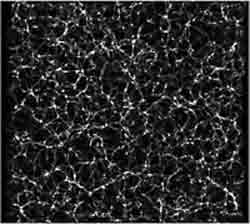
Clues revealed by the recently sharpened view of the Hubble Space Telescope have allowed astronomers to map the location of invisible “dark matter” in unprecedented detail in two very young galaxy clusters.
A Johns Hopkins University-Space Telescope Science Institute team reports its findings in the December issue of Astrophysical Journal. (Other, less-detailed observations appeared in the January 2005 issue of that publication.)
The team’s results lend credence to
For a mathematician, Joseph Biello spends a lot of time thinking about the weather. But the UC Davis assistant professor isn’t looking out the office window. He is using mathematical theory to build a model of the Madden-Julian Oscillation, a tropical weather pattern that influences drought and rainfall in the western U.S.
The Madden-Julian Oscillation was discovered in 1972 when researchers looked closely at meteorological data. It lasts 30 to 60 days and appears as cl
Glaciers, rivers and shifting tectonic plates have shaped mountains over millions of years, but earth scientists have struggled to understand the relative roles of these forces and the rates at which they work.
Now, using a new technique, researchers at the University of Michigan, California Institute of Technology and Occidental College have documented how fast glaciers eroded the spectacular mountain topography of the Coast Mountains of British Columbia.
Their work
Absent any climate policy, scientists have found a 70 percent chance of shutting down the thermohaline circulation in the North Atlantic Ocean over the next 200 years, with a 45 percent probability of this occurring in this century. The likelihood decreases with mitigation, but even the most rigorous immediate climate policy would still leave a 25 percent chance of a thermohaline collapse.
“This is a dangerous, human-induced climate change,” said Michael Schlesinger, a professo
While the rupture zones of recent major earthquakes are immune to similar-sized earthquakes for hundreds of years, they could be vulnerable to even bigger destructive temblors sooner than scientists suspect, according to analysis by University of Colorado seismologist Roger Bilham.
Bilham and his research colleagues explained that the magnitude 9.3 Indian Ocean earthquake of December 2004 showed scientists that a giant earthquake can rupture through a region with a recent histor
After some 400 years of relative stability, Earth’s North Magnetic Pole has moved nearly 1,100 kilometers out into the Arctic Ocean during the last century and at its present rate could move from northern Canada to Siberia within the next half-century.
If that happens, Alaska may be in danger of losing one of its most stunning natural phenomena – the Northern Lights.
But the surprisingly rapid movement of the magnetic pole doesn’t necessarily mean that our plane